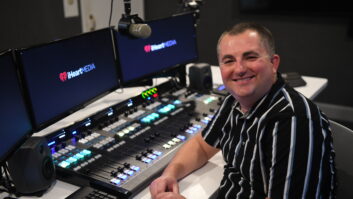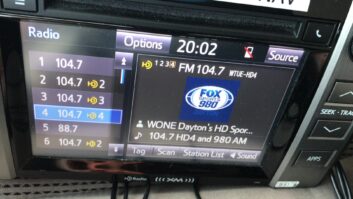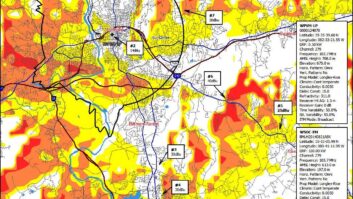IBOC Around the World
Nov 1, 2008 12:00 PM, By Doug Irwin, CPBE AMD
Those interested in the technology news of radio broadcasting are likely well aware that Ibiquity touts about 1,794 AM and FM radio stations in the U.S. now transmitting IBOC signals. Also, there are about 900 multicast signals being transmitted. So while HD Radio gains acceptance in the U.S., it is also making waves in other countries around the world. Let”s take a quick trip around the world to look at more of the details.
Mexico”s Comisi�n Federal de Telecomunicaciones (Cofetel) has recently authorized IBOC transmissions using the Ibiquity system for stations within 200 miles of the U.S. border. The official Cofetel statement can be translated to: �Considering the extent of the development and implementation of the IBOC system in the United States of America, Mexico is required to take decisive action so that the country”s AM and FM radio stations in the zone located within 320km of the northern border of Mexico can transmit at the same technological level so that they can provide the benefits of quality service to the radio listening public.�
Mexican stations that have purchased HD Radio equipment so far include XEEZ in Caborca, Sonora, and XHDL and XEDA in Mexico City.
Our Canadian colleagues have tested Ibiquity”s HD Radio technology as well. A well-written technology review can be found in CBC Technology Review, July 2007. This article thoroughly reviews the technology, discusses how the test platform was built, and draws conclusions at the end. (Tests were carried out on CBLA-FM and CJBC-FM in Toronto). One such conclusion reads: �HD Radio technology is considered to be ready for operation in the United States. This service will probably be offered in Canada as well. However, current spectrum management regulations preclude the introduction of such service. Interference with existing analog FM stations is one of the issues the regulators will have to resolve when reviewing their spectrum management rules.� The testing in Ontario went on between Aug. 30 and Dec. 20, 2006; and interestingly, the CRTC published notice 2006-160 addressing the implications of the use of the Ibiquity”s technology (among other things) on Dec. 15 of the same year.
Paragraph 55 of 2006-160 reads: �In light of the evidence presented in the course of this public proceeding, the Commission has concluded that, if the aforementioned issues can be addressed, particularly any potential interference to other stations, the use of IBOC technology, which enables the transition to digital without consuming additional spectrum and allows for the provision of supplementary program information and multicast services, could be considered for licensing.� It should be noted that DRM was another IBOC technique under consideration by the CRTC.
Heading overseas
There is interest in Ibiquity HD Radio technology in Europe as well. The European HD Radio Alliance had its first meeting in Lucerne, Switzerland, in October 2007. It probably isn”t too much of a stretch to conclude the Alliance formed at the same location as the first HD Radio implementation in Switzerland: 88 Radio Sunshine.
Tests of the Ibiquity system there were considered to be very successful, according to the station owners themselves.
Tests of the HD Radio system were also conducted in Paris by Towercast (a privately-held company that manages radio transmission facilities), NRJ Group and SIRTI, which is an association of some 120 local and regional broadcasters throughout France. According to Ibiquity, though, the Ministry of Communications in France has excluded its technology from consideration as a means to �digitize� the VHF FM band there, in spite of claims by SIRTI (based presumably on the real-world testing results) that the technology would in fact work for that process.
One of Germany”s privately held radio stations, Radio Regenbogen, began testing the Ibiquity system last December. Testing of the system began in the Prague (Czech Republic) in February 2007, and in Poland at the beginning of 2006.
South of the border and east
South America has a considerable amount of interest in the HD Radio technology. According to Ibiquity, Continental Lensa, based in Santiago, Chile, became the first electronics manufacturer outside North America to be licensed to build HD Radio equipment. That may be in part because of the fast growth of HD Radio in Brazil. The Brazilian Alliance for Digital Radio is made of the major broadcasting groups there, including the Association of Broadcasters of Sao Paulo and the Brazilian Association of Radio and Television Broadcasters. One of the first stations to transmit HD Radio outside the U.S. is KISS-FM of Sao Paolo, which has been on the air since October 2005. Now some 25 stations (AM and FM) are on the air throughout Brazil, providing HD Radio service to 30 million potential listeners.
Testing of HD Radio technology has been tested in Buenos Aires, Argentina, as well.
Turning our attention to the western Pacific, we see that HD Radio has generated a considerable amount of interest in that region of the world as well. The first HD Radio transmission in the Philippines occurred in November of 2005; however the first usage of the HD Radio technology in commercial radio began in 2006 when DWKC in Manila started testing its digital systems.

HD Radio has been tested or deployed in several countries around the world.
Testing of Ibquity”s technology has occurred in Auckland, New Zealand, from the Sky Tower. Initial results indicated that the 370mW ERP was enough to provide a digital signal to 60 percent of the potential audience in Auckland. A further 12-month testing session was scheduled be begin in March 2007.
At least one test transmission of Ibiquity”s technology has been carried out in Australia, and that began in September 2006.
Farther afield
HD Radio has come to Indonesia: Surabaya has its first AM HD Radio station on 1062kHz; Jakarta has JDFI-FM on 101.8MHz.
Metro Radio of Hong Kong demonstrated the HD Radio technology during the ITU Telecom World Conference there in December 2006. June 2008 saw the beginning of HD Radio transmissions in Hanoi, Vietnam.
Perhaps the biggest potential market for HD Radio is China, and testing of the system began there this past February, and is continuing throughout this year.
Historically the United States has been at the forefront of broadcast radio technology � first with AM, then FM and now with IBOC technology. Likely the cause of that is because radio has long been an important business in the U.S. � more so than any other country. The original idea behind the development of IBOC � making use of spectrum that was already available, but for digital modulation � makes complete sense to other broadcasters and government agencies the world over. The development and promulgation of HD Radio in the far corners of the world is good for the industry here in the States and shows that the business we all know has lots of life left in it.












